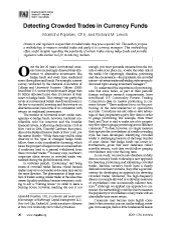Detecting Crowded Trades in Currency Funds
by Momtchil Pojarliev, CFA, and Richard M. Levich
Financial Analysts Journal
vol. 67, no. 1, 2011, (Jan/Feb), pp. 26-39
The financial crisis of 2008 highlights the importance of detecting crowded trades due to the risks they pose to the stability of the financial system and to the global economy. However, there is a perception that crowded trades are difficult to identify. To date, no single measure to capture the crowdedness of a trade or a trading style has developed. We propose a methodology to measure crowded trades and apply it to professional currency managers. Our results suggest that carry became a crowded trading strategy towards the end of Q1 2008, shortly before a massive liquidation of carry trades. The timing suggests a possible adverse relationship between our measure of style crowdedness and the future performance of the trading style. Crowdedness in the trend following and value strategies support this hypothesis.
Our sample period covers 63 months, of which 27 months are effectively an out-of- sample period. The out-of-sample results confirm the usefulness of our measure of crowdedness. After a period when carry returns were very favorable, carry became crowded again in fall 2009, and then experienced a sharp reversal during the European sovereign debt crises and after the "flash crash" in May 2010.
We apply our approach to currencies but the methodology is general and could be used to measure the popularity or crowdedness of any trade with an identifiable time series return. Our methodology may offer useful insights regarding the popularity of certain trades – in currencies, gold, or other assets – among hedge funds. Further research in this area may be relevant for investors, managers and regulators.
Download
the paper

Click to download
